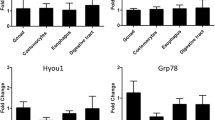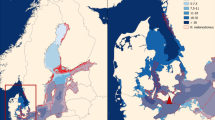Abstract:
Expression of heat shock proteins (HSPs) is often correlated with adaptation to environmental stress. We examined the role of HSP60 (60 kDa) in acclimatization to thermal stress in the sea anemone Anemonia viridis. Using monoclonal antibodies, we identified HSP60 in sea anemones for the first time, and showed that its expression varied with changes in seawater temperature (SWT). Anemonia viridis displayed high levels of HSP60 when extreme temperatures prevailed in stressful habitats such as tidal pools. Specimens sampled from different temperature layers in the same tidal pool differed in their levels of HSP60. Specimens from subtidal zones exhibited a seasonal pattern of expression of HSP60, according to the seasonal SWT. The level of HSP60 was significantly higher in the summer (SWT, 31°C) than in other seasons throughout the year. This study suggests the use of HSP60 expression as a tool for stress detection in marine invertebrates.
Similar content being viewed by others
Author information
Authors and Affiliations
Additional information
Received September 25, 2000; accepted February 26, 2001.
Rights and permissions
About this article
Cite this article
Choresh, O., Ron, E. & Loya, Y. The 60-kDa Heat Shock Protein (HSP60) of the Sea Anemone Anemonia viridis: A Potential Early Warning System for Environmental Changes. Mar. Biotechnol. 3, 501–508 (2001). https://doi.org/10.1007/s10126-001-0007-4
Issue Date:
DOI: https://doi.org/10.1007/s10126-001-0007-4




